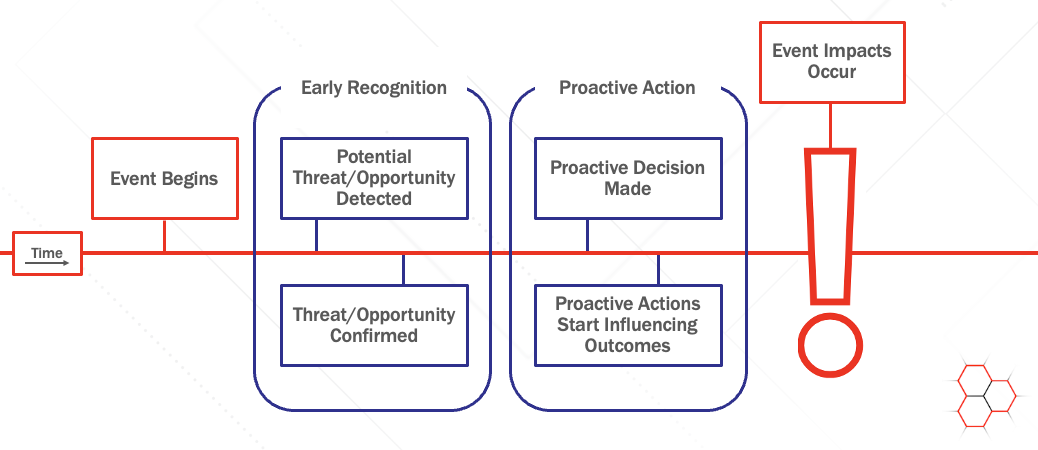School Threat Assessments, Evacuations, Left of Bang Skills & More
Profiles in Preparedness #35
There’s a clear theme in this week’s articles: the real work required to get left of bang—not just in theory, but in practice.
In practice, organizations must navigate four distinct steps, each requiring its own set of skills:
Recognize potential threats or opportunities early.
Confirm whether they are real or if they are events you care about.
Decide on a course of action before the event unfolds.
Act with enough time to influence the outcome.
As the visual above shows, even the best-laid plans depend on early recognition. A decision that’s never prompted is never made. And even when a threat is identified, if an organization struggles to assess it or delays confirmation, action doesn’t follow. When the right questions aren’t asked—or the wrong signals are chased—vital time is lost.
These four steps aren’t just a model for future readiness. They’re also a tool for reverse-engineering what went wrong in past incidents. Because when you can recognize what’s coming early enough, you don’t just prepare—you shape the outcome.
That’s what it takes to get left of bang.
This Week‘s Reads
Here are a few standout reads from this week with insights, ideas, and perspectives that caught my attention.
Article | The Three Skills That Still Matter Most. In last week's newsletter, I spoke about the need for "discernment" (knowing exactly what to do, and why) in the context of taking action, but in this article, Alan Berkson hits on a really important component of discernment for organizational leaders. With traditional gatekeepers of information being bypassed, it is now the responsibility of everyone to vet and check their information sources (as part of knowing what they should be doing). As you give this article a read, stop and reflect for a moment about who is behind the information you're using to make decisions.
Article | When is a school shooting threat real? While I was giving a presentation this week, I had the chance to hear a story about an attack that wasn't prevented, even though the future shooter had been flagged for law enforcement. One of the reasons why we highlight the elements of getting left of bang in this week's introduction is because it can also be a diagnostic tool to identify which capability is your current limiting factor. Threat assessment is a common gap because "making a threat" and "being a threat" are two very different things. This article looks at some of the challenges that go into that in a school setting, noting how the "observer effect" can change the outcome of events (in both good and bad ways).
Article | How to Prepare for Natural Disasters if You Have a Disability. Using the 2018 Camp Fire in Paradise, CA, and the 2023 Lahaina Fire in Maui, HI as examples, elderly people perish in wind-driven fires at a disproportionate rate. Similar to people with disabilities, this portion of our communities requires information earlier in the left-of-bang window than other parts, as it may take additional time to relocate to a safe location. However, even with a detailed plan for how they can do that before requiring the support of first responders, they can't put those plans into action without first knowing they are at risk. They need to know earlier.
The challenge is that local governments often don’t send alerts when a new wildfire ignites. Often, the first time they message the public is when they need to evacuate. For this portion of the community, though, this might be too late. Yet, this is also why I am excited about the innovations coming online in the disaster management industry that are changing the left of bang equation.
Apps like Watch Duty offer the opportunity for people to receive a push notification for new fire starts (once their platform detects the new incident, and on-scene personnel give an official report on conditions). And this week, they announced the ability to see fire progression models for some fires. Now, a person can not only learn about a new fire start, but they can also see where it may go, better understand their risk, and make informed decisions. This is an incredible step forward.
When You’re Ready
If you want more in-depth insights, you can become a paying subscriber to access exclusive content like our weekly Watch Office situation reports, our Tactical Analysis Course & behavioral analysis practice exercises, and the “Project Management in Emergency Management” Playbook.
And if you’re thinking about how to strengthen your organization's preparedness, that’s what we do. Whether it’s assessments, planning, speaking events, or exercises, we help teams build the skills and strategies to stay ahead of the next challenge.


